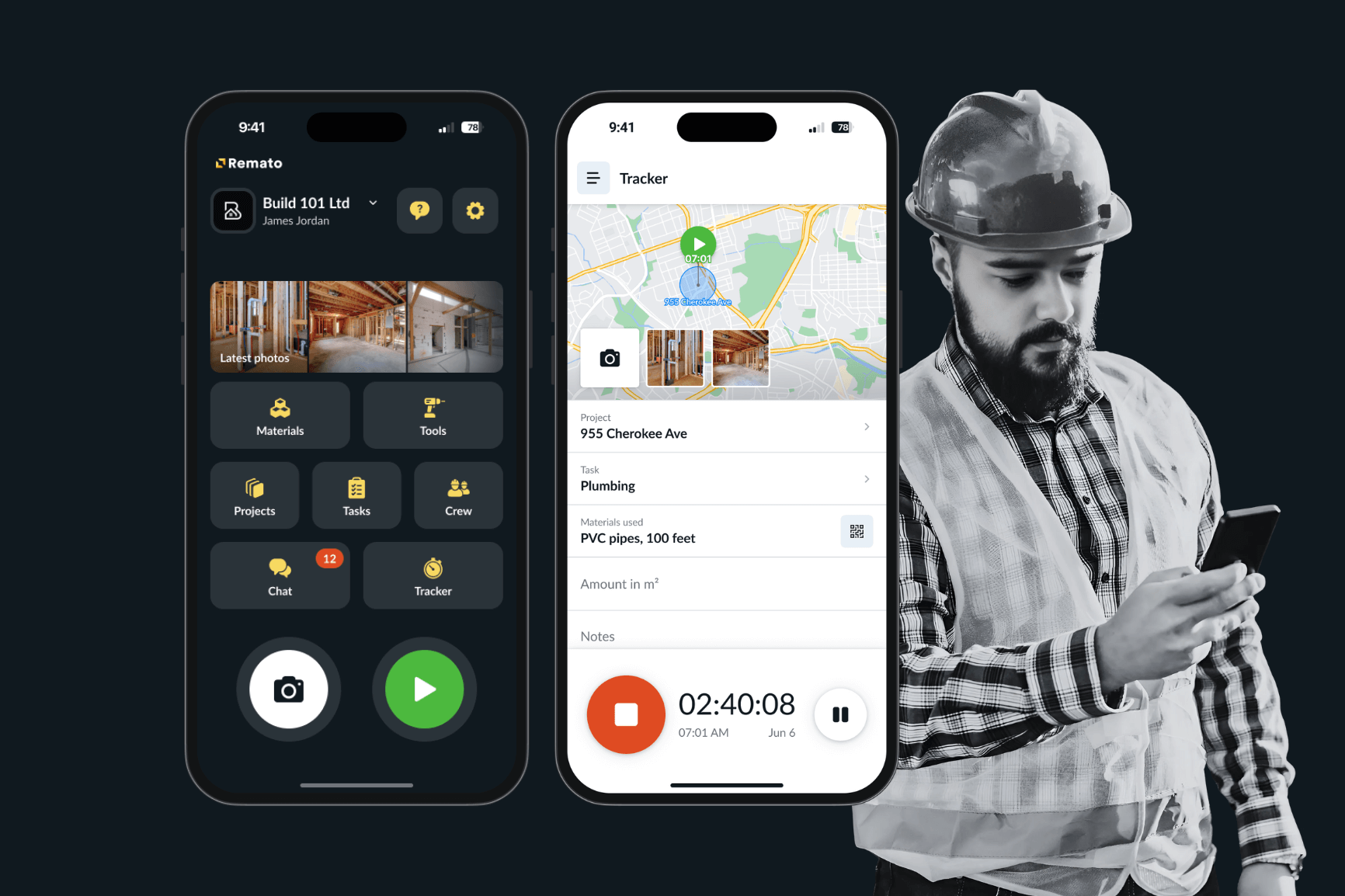Why Crew on Site and Subcontractors Abandon Construction Software (and What They Actually Need)
Walk onto almost any job site and you’ll hear the same frustration from a foreman or a subcontractor:
“We tried that software… but the crew hated it. Nobody kept up with it.”
It’s a pattern across the construction industry. Companies invest in new project management systems, construction field management software, or scheduling tools, hoping for better coordination and visibility. But within weeks, enthusiasm fades. Crews stop entering data. Subcontractors ignore the platform. And managers are left juggling spreadsheets, text messages, and paper notes again
— all while trying to maintain even basic construction crew management processes.
So, what’s going on? Why do field teams and subcontractors abandon construction field software so quickly? And more importantly, what do they actually need to make technology stick — especially considering the broader technology adoption in construction industry challenges?
The short answer: if software doesn’t feel like it was built for the crew on site, it won’t survive. The long answer takes us through usability, mobile practicality, and the daily reality of construction work. Let’s break it down.
Table of Contents
The Day-to-Day Reality on Site
To understand why software adoption fails, you need to picture the crew on site. These aren’t people sitting in front of dual monitors with all day to type in notes. They’re:
- Moving between tasks constantly.
- Wearing gloves, holding tools, climbing scaffolding.
- Working against tight deadlines and weather conditions.
- Communicating with multiple trades at once.
Now imagine asking them to log into a complex software, find the right project, select the right form, and manually type in updates. Even if the platform promises rich features, it’s simply not realistic — especially when crews already rely on fast, practical workflows and basic construction job management routines they know by heart.
Furthermore, subcontractors often juggle multiple projects for different general contractors. If each GC uses a different system, the subcontractor’s crew may face three or four separate logins and workflows. That’s a non-starter for adoption.
Construction software that feels like extra work will never compete with the pace of real construction tasks.
Recent surveys underline that misfit workflow design and extra effort required from tech-challenged crews are major barriers to construction innovation uptake.
Why Field Teams Quit New Software
Let’s call out the most common reasons crews and subcontractors give up:
a) Too Many Steps
When logging hours or reporting quantities takes more than a few taps, the crew on site reverts back to the quickest method: texting the foreman or writing on paper.
b) Poor Mobile Design
A web app designed for desktops, shrunk down for phones, is frustrating. Scrolling, zooming, and searching for the right button while standing in the sun or rain? That’s when adoption dies.
c) Lack of Offline Access
Many job sites don’t have reliable signal. If the app only works online, data entry gets skipped. Crews won’t “remember to add it later.”
d) Disconnect Between Hours and Quantities
Workers want to log both what they did and how long it took. If the system ties quantities strictly to hours, it creates confusion. Teams want independent but connected data entry.
e) No Real Benefit for the Worker
If the software feels like it’s only feeding management reports but offers nothing in return like making payroll smoother or tool tracking easier the crew on site has zero motivation to use it consistently.
What Field Teams Actually Need
After interviewing and working with dozens of companies, the pattern is clear: adoption only happens when field management software for construction teams directly supports the crew on site.
Here’s what that looks like:
1. Simplicity Above All
One screen. Big buttons. Clear labels. Workers don’t want tutorials or handbooks; they want something obvious.
2. Mobile-First Construction Design
This is critical. A mobile-first construction app is designed for the phone in a worker’s pocket, not a laptop in the trailer. That means:
- Offline access.
- Quick taps instead of typing.
- Photos as an input method (faster than typing text).
- Built for dirty hands, small screens, and on-the-go updates.

3. Immediate Value
When workers clock hours and see their timesheet update instantly for payroll, they care. When they upload photos and avoid endless WhatsApp threads, they care. When their tool checkouts are visible without chasing managers, they care.
4. Separation of Work and Time
Being able to log “we poured 15 cubic meters” separately from “we worked 6 hours” allows more accurate tracking. Crews know that time ≠ output, and software must reflect that.
5. Minimal Disruption
If a subcontractor can use the same app across multiple projects without relearning, they’ll stick with it. Standardisation matters more than most managers realize.
A Case in Point: Real Adoption with Ease of Use
Let’s look at a company that went through this.
They had tried software after software: Procore, Raken, Fieldwire, and more. Every time, the same result: office staff liked the dashboards, but the crew on site abandoned the app.
Then they tested Remato, a mobile-first construction platform. Why did it work?
- Field staff found it intuitive within days.
- The mobile app handled everything – no more running to the office computer.
- The photo tool became the most-used feature, since it was quick and practical.
- Payroll managers finally got consistent time logs without begging crews for updates.
The difference wasn’t fancy features. It was simplicity plus mobile-first construction design. That combination turned adoption from “barely surviving” into “daily habit.”
Why Subcontractors Are the Hardest to Win Over
Subcontractors are unique. They’re independent, move fast, and work across multiple jobs. If you ask them to learn complex software for one GC’s project, they’ll resist — this is one of the biggest bottlenecks in construction technology adoption across the industry.
However, subcontractors respond well to software that:
- Works across different projects.
- Requires almost no setup or training.
- Saves them time chasing paperwork or payment approvals.
When software reduces their headaches instead of adding to them, they’ll use it—even promote it. And once subcontractors are on board, adoption by the crew on site follows naturally.
The “Mobile-First Construction” Standard
The phrase “mobile-first construction” isn’t just marketing. It’s a practical requirement. A crew on site doesn’t need dashboards with 20 widgets, here is what they actually need:
- A fast way to clock in/out.
- A place to drop photos of progress or issues.
- Simple task tracking tied to today’s work.
Every time mobile-first construction design is overlooked, adoption suffers. Every time it’s prioritised, adoption grows.
What Adoption Looks Like in Practice
Adoption doesn’t mean “workers tolerate it.” It means the crew on site actively uses the app because it fits their workflow. Signs of real adoption include:
- Photos uploaded daily without reminders.
- Time tracking done in real-time, not at the end of the week.
- Subcontractors voluntarily logging quantities because it benefits them.
- Managers spending less time chasing data, more time making decisions.
This doesn’t happen with complex software. It happens with tools that are easy, fast, and mobile-first construction at the core. This is how modern field view construction software should work.
Moving Forward: How to Choose Software Crews Will Actually Use
If you’re a project manager or foreman deciding on software, here’s the filter to apply:
- Can a worker figure this out without training?
- Does it work flawlessly on a smartphone, even offline?
- Does it save time for the crew, not just management?
- Can subcontractors use it across jobs without headaches?
- Does it separate hours from quantities, but still connect them in reports?
For many teams, evaluating tools like contractor project management software can provide a clearer understanding of what actually supports field workflows rather than complicating them.
If the answer is “no” to any of these, expect abandonment.
Usability and real-world fit are major factors in the acceptance of technology in construction, according to multiple studies that includes more than 124 peer-reviewed publications. This supports the need of tailoring the software to the crew on site.
Conclusion: Why Ease of Use + Mobile Tools = Real Adoption
Construction software adoption isn’t about features or buzzwords. It’s about fitting into the daily grind of the crew on site. If the software is easy, mobile-first, and actually helpful — especially when it functions as truly practical construction field management software — it will stick. If it isn’t, crews will drop it, fast.
The case study proves it: ease of use plus mobile-first construction tools equals real adoption.
When the industry finally accepts that technology must adapt to the worker and not the other way around we’ll see software that crews want to use, not software they abandon.
Frequently Asked Questions
1. What is construction field management software ?
Construction field management software is a digital tool designed to manage tasks, time tracking, reporting, and on-site communication directly from the jobsite. It helps crews, foremen, and subcontractors keep everything organized in real time, reducing paperwork and miscommunication. By centralizing daily operations in one mobile-friendly platform, it improves efficiency and visibility across the entire project.
2. Why do crews abandon construction field software ?
Crews usually drop construction field software because it slows them down — too many clicks, confusing workflows, or poor mobile performance. If the tool doesn’t work reliably on-site, offline, and with minimal effort, workers simply revert to faster methods like texting, calling, or paper notes.
3. What is field view construction software used for?
For capturing job progress with photos, tracking tasks, and providing real-time visibility into field operations.
4. How can field management software for construction teams improve productivity?
Field management software for construction teams improves productivity by streamlining daily workflows, reducing manual paperwork, and giving crews clear, real-time instructions. When workers can log progress, time, and photos instantly from the jobsite, managers make faster decisions and avoid costly delays. This leads to smoother coordination, fewer mistakes, and higher overall efficiency.
5. Why is technology adoption in construction industry so challenging?
Technology adoption in the construction industry is difficult because most tools are not designed for real jobsite conditions — crews need offline access, speed, and extremely simple workflows. Many platforms are built for office use, not field realities, which creates friction and resistance from workers. Without software that matches how crews actually work, adoption collapses quickly.
